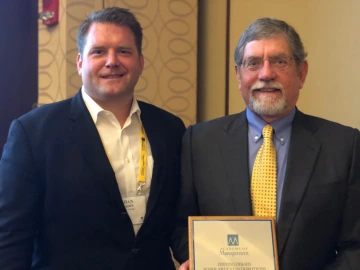Research Conducted by Nathan Podsakoff Recognized as One of the Most Cited Articles in History

Research co-authored over 20 years ago by Nathan Podsakoff, head of the department of management and organizations and his father, Philip Podsakoff, has been recognized as one of the most influential scientific articles in modern history by Nature, the world's leading multidisciplinary science journal

Nathan Podsakoff (Left) and Phillip Podsakoff (Right) at the 2019 Academy of Management meetings, where Phillip was awarded AOM’s Distinguished Scholarly Contributions to Management Award.
The paper, Common Method Biases in Behavioral Research: A Critical Review of the Literature and Recommended Remedies, published in the Journal of Applied Psychology in 2003, was recently ranked by Nature as the 17th most cited scientific article of the past 25 years—out of more than 72 million papers tracked during that time by the Web of Science. Even more notably, it now ranks as the 42nd most cited scientific article of all time, across 121.5 million publications dating back to 1900.
Co-authored with Scott MacKenzie and Jeong-Yeon Lee, the article tackled a critical but often overlooked issue in research design: method bias, or the distortions that arise from how data is collected and measured—particularly in studies relying on self-report surveys or single-source data.
Although the idea of method bias wasn’t new, the field lacked a comprehensive guide for how to identify and control for it. The Podsakoffs and their co-authors filled that gap by reviewing decades of literature, outlining sources of bias, explaining the cognitive processes behind them, and offering both procedural and statistical remedies. The paper provided a clear and actionable framework that researchers across disciplines could use to improve the validity of their findings.
"I am proud of the research that Phil and I have worked on together but our 2003 Journal of Applied Psychology article clearly resonated with other academics the most. [...] As management scholars, we want our work to positively affect others – in terms of their research, how employees and organizations function, and through better policies and practices – but neither Phil nor I could have predicted the effect of this article. [...] I am unlikely to do anything more impactful than this research during my career and I am proud to have been involved in this work."
The impact of the paper has extended far beyond behavioral science, influencing work in psychology, marketing, education, healthcare and management. It remains a cornerstone reference for anyone designing or analyzing behavioral studies.
Two decades later, the article continues to shape how behavioral research is conducted. Its recognition by Nature not only highlights its scientific impact, but also honors a rare academic collaboration between father and son—one that has left a permanent mark on the world of research.

